What’s Beautiful Now: A Mild February
Posted in Around the Garden, What's Beautiful Now on February 23 2012, by Matt Newman
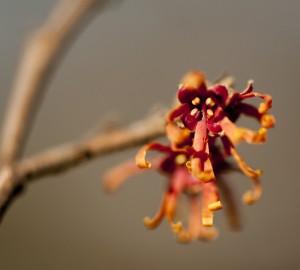 Nearing spring, we find plenty to be excited about as we walk through The New York Botanical Garden’s outdoor collections. Not that there isn’t a faint sense of curiosity, too; as Sonia Uyterhoeven has explained before, the weather patterns this winter have tricked certain plants into breaking dormancy early, resulting in a few blooms that will end up missing their spring date. But regardless, we appreciate the beauty whenever it happens to come around. And many of these flowering plants are proving right on time.
Nearing spring, we find plenty to be excited about as we walk through The New York Botanical Garden’s outdoor collections. Not that there isn’t a faint sense of curiosity, too; as Sonia Uyterhoeven has explained before, the weather patterns this winter have tricked certain plants into breaking dormancy early, resulting in a few blooms that will end up missing their spring date. But regardless, we appreciate the beauty whenever it happens to come around. And many of these flowering plants are proving right on time.
As a test of their savvy, our newest School of Professional Horticulture students were sent out into the Garden to record each outdoor flowering plant they came across, perusing the collections from one side to the other. The wealth of information they came up with was too much even for me to soak up. But I was able to sort through and pick out a few of the blooms for visitors to see while walking the grounds. It’s a great jump on spring’s inevitable explosion of color!
Amur adonis (Adonis amurensis)
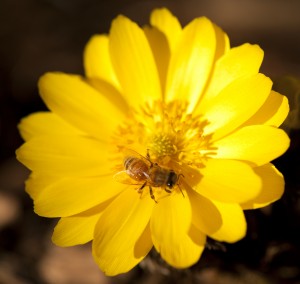 This one has been catching my eye for the past week or two as I occasionally putter along the Ladies’ Border. The space always carries some of the more interesting blossoms thanks to its location, tucked in between the edge of the Conservatory and a berm that insulates it from the worst of the weather. Plants just thrive more readily there–even those that aren’t quite rated for our growing zone.
This one has been catching my eye for the past week or two as I occasionally putter along the Ladies’ Border. The space always carries some of the more interesting blossoms thanks to its location, tucked in between the edge of the Conservatory and a berm that insulates it from the worst of the weather. Plants just thrive more readily there–even those that aren’t quite rated for our growing zone.
The adonis is a welcome addition to the path. Its bright petals flare up like gold in the sunlight, and there always seems to be at least a few honey bees patrolling between the flowers. In recent weeks the yellow blossoms of the Adonis have magnetized nearby photographers, drawing them in droves. On at least one occasion, the crowd actually thwarted my early attempts to photograph these small plants.
Paper bush (Edgeworthia chrysantha ‘Akabana’)
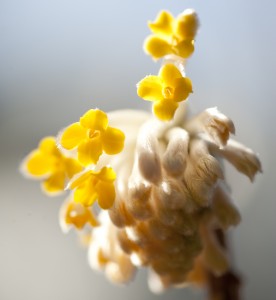 Hailing from China and Japan, the paper bush has been making the rounds in the gardening trade for at least 150 years, though its popularity among gardeners themselves had not spiked until recently. The lore held over from the 1930s suggested that this particular woody, flowering shrub was not hardy anywhere north of Florida. The mistake cost home horticulturists decades of enjoyment.
Hailing from China and Japan, the paper bush has been making the rounds in the gardening trade for at least 150 years, though its popularity among gardeners themselves had not spiked until recently. The lore held over from the 1930s suggested that this particular woody, flowering shrub was not hardy anywhere north of Florida. The mistake cost home horticulturists decades of enjoyment.
Another star of the Ladies’ Border, our Edgeworthia is flowering nicely with casually fragrant white and yellow blooms. Whether with a single trunk or multiple stems, the paper bush grows to a reliable size of around four feet wide by five feet tall, making it the ideal addition to any diverse home garden.
Japanese apricot (Prunus mume ‘Matsurabara Red’)
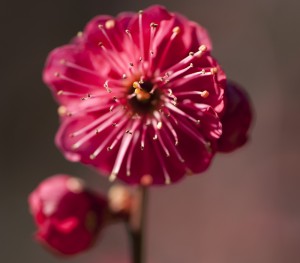 A recent regular in our Morning Eye Candy posts, the Japanese apricot (or Chinese plum) is lighting up the Garden in the cooler months, producing flowers across a wide spectrum of color. In my case, its delicate, parasol-esque blooms remind me specifically of the quintessential eastern Asian aesthetic. Thanks to a tradition of botanical artwork in countries such as Japan, China, and Korea, these flowers have become a centerpiece of the artform, right alongside the ubiquitous cherry blossom.
A recent regular in our Morning Eye Candy posts, the Japanese apricot (or Chinese plum) is lighting up the Garden in the cooler months, producing flowers across a wide spectrum of color. In my case, its delicate, parasol-esque blooms remind me specifically of the quintessential eastern Asian aesthetic. Thanks to a tradition of botanical artwork in countries such as Japan, China, and Korea, these flowers have become a centerpiece of the artform, right alongside the ubiquitous cherry blossom.
Lenten-rose (Helleborus x hybridus)
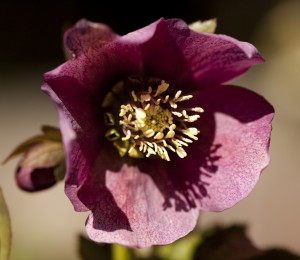 The hellebores in the Home Gardening Center have a regal charm to them, with a dusty-hued purple tone to their flower petals. Appropriately, the breed originates in regions across Europe.
The hellebores in the Home Gardening Center have a regal charm to them, with a dusty-hued purple tone to their flower petals. Appropriately, the breed originates in regions across Europe.
While our hellebores are of a variety that leans toward various shades of red, the genus has become known by many for its broad number of green-petaled species, which stand out in a garden of colorful flowers for their subtle differences in shade between bloom and foliage.
Winter honeysuckle (Lonicera fragrantissima)
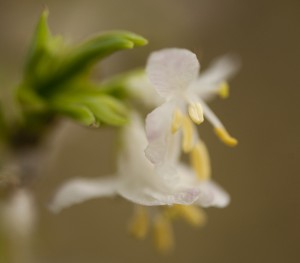 Outside of careful cultivation, winter honeysuckle can in some regions be considered an invasive weed. But here at the NYBG, with proper attention, it’s become a welcome addition to the Everett Children’s Adventure Garden. Its cheerful white flowers and light fragrance make it all the more appreciated.
Outside of careful cultivation, winter honeysuckle can in some regions be considered an invasive weed. But here at the NYBG, with proper attention, it’s become a welcome addition to the Everett Children’s Adventure Garden. Its cheerful white flowers and light fragrance make it all the more appreciated.
Much like the Red-winged Blackbirds mentioned in a recent post, winter honeysuckle is considered a “harbinger of spring.” Seeing it liven up the Adventure Garden in February gives us hope for the kind of early change of seasons the groundhogs couldn’t agree upon.
Asiatic dogwood (Cornus officinalis)
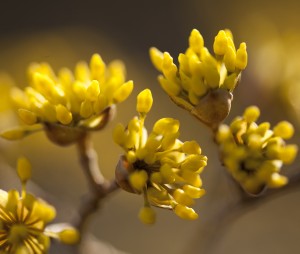 The Asiatic dogwood is known for its many applications in traditional Chinese medicine, but the NYBG tends to appreciate it for its small and abundant yellow flowers. The sparse branches bursting with collections of blossoms make for a centerpiece addition to the south arboretum.
The Asiatic dogwood is known for its many applications in traditional Chinese medicine, but the NYBG tends to appreciate it for its small and abundant yellow flowers. The sparse branches bursting with collections of blossoms make for a centerpiece addition to the south arboretum.
The fruit of this dogwood is often known as the Cornelian cherry, a raw edible also known for its rumored medicinal uses.

